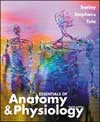 |  Essentials of Anatomy & Physiology, 4/e Rod R. Seeley,
Idaho State University
Philip Tate,
Phoenix College
Trent D. Stephens,
Idaho State University
The Skeletal System - Bones and Joints
Study OutlineFunctions of the Skeletal System
Bone(Fig. 6.1, p. 113)Support
Protection
Lever system
Mineral storage
Blood cell formation
Cartilage
Model for bone growth
Smooth joint surfaces
Support
Tendons and ligaments form attachments
Connective Tissue
Cartilage-extracellular matrix
Collagen
Proteoglycans
Bone-extracellular matrix
Collagen
Hydroxyapatite
General Features of Bone
Bone shapes
Long bones
Short bones
Flat bones
Irregular bones
Long bone anatomy (Fig. 6.2, p. 115)Bone histology
Compact bone(Fig. 6.3, p. 116)Cancellous bone(Fig. 6.4, p. 117) Bone ossification
Intramembranous ossification(Fig. 6.5, p. 117) Endochondral ossification(Fig. 6.6, p. 118) Bone growth
Increase in diameter
Endochondral growth - increase in length(Fig. 6.7, p. 119) Bone remodeling(Fig. 6.8, p. 120)Bone repairClinical Focus: Bone Fracturesp. 120
The Skeleton(Fig. 6.9, p. 123, Tbl. 6.1, p.122) General Clinical Focus: Skeletal Disordersp. 121
Considerations of bone anatomy(Table 6.1, p. 122)Terms for bone features(Table 6.2, p. 124) Axial skeleton
Skull
Lateral view(Fig. 6.10, p. 124)Frontal view(Fig. 6.11, p. 125)Paranasal sinuses(Fig. 6.12, p. 126)Interior of the cranial vault(Fig. 6.13, p. 127)Base of skull from below(Fig. 6.14, p. 128) Vertebral column(Fig. 6.15, 6.16, p. 129)
(Fig. 6.21, p. 133 - surface view)Regional differences(Fig. 6.17, p. 130)Sacrum and coccyx(Fig. 6.18, p. 131)Thoracic cage(Fig. 6.19, p. 131)Ribs and costal cartilage
Sternum
Appendicular skeleton
Pectoral girdle
Scapula(Fig. 6.20, p. 132)Clavicle
Upper limb(Fig. 6.25, p. 135 - surface view) Arm-humerus(Fig. 6.22, p. 133) Forearm-radius and ulna(Fig. 6.23, p. 134) Wrist and hand(Fig. 6.24, p. 135) Pelvic girdle(Fig. 6.26, p. 136) Comparison of male and female(Fig. 6.28, Tbl. 6.3, p. 137) Lower limb(Fig. 6.32, p. 140 - surface view)Thigh--femur(Fig. 6.29, p. 138) Leg--tibia and fibula(Fig. 6.30, p. 139)Ankle and foot(Fig. 6.31, p. 140) ArticulationsClinical Focus: Joint Disorders p. 147
Fibrous joints(Fig. 6.33, p. 141)Cartilaginous joints
Synovial joints(Fig. 6.34, p. 142)Types(Fig. 6. 35, p. 143)Plane joint
Saddle joint
Hinge joint
Pivot joint
Ball-and-socket joint
Ellipsoid joint
Selected joints(Fig. 6.36, p. 144)Types of movement(Fig. 6.37, p. 145-146)Flexion and extension
Abduction and adduction
Pronation and supination
Eversion and inversion
Rotation
Protraction and retraction
Elevation and depression
Opposition and reposition
Circumduction
Systems Pathology - OsteoporosisSystems Interaction Table p. 149
|
|



 2002 McGraw-Hill Higher Education
2002 McGraw-Hill Higher Education